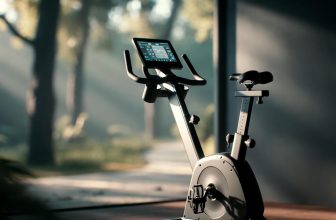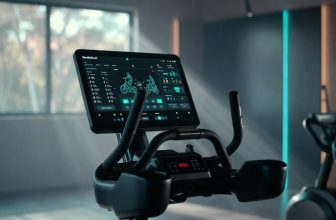Table of Contents
- Can You Ride a Peloton with Regular Shoes?
- Understanding Peloton Pedals and Shoe Compatibility
- Safety Risks of Using Regular Shoes on Peloton
- How to Ride Peloton with Regular Shoes: Accessories and Modifications
- Toe Cages and Straps
- Dual-Sided or Flat Pedals
- Benefits of Switching to Proper Peloton Cycling Shoes
- User Experiences and Statistics on Peloton Shoe Choices
- FAQ
- Can beginners ride Peloton without any special shoes?
- How do I know if my regular shoes are safe for Peloton?
- What’s the cheapest way to use regular shoes long-term?
- Do Peloton shoes work on other spin bikes?
- How often should I replace cycling shoes for Peloton?
- Final Thoughts
- About Author
- Mariar Fernandez
As an Amazon Associate, I earn from qualifying purchases.
Can You Ride a Peloton with Regular Shoes?
Can You Ride a Peloton with Regular Shoes? Yes, you can ride a Peloton bike with regular shoes, but it’s not ideal for safety, efficiency, or long-term use. Use toe cages or flat pedals for secure footing, and limit sessions to low-intensity rides under 100 RPM to avoid slippage.
Understanding Peloton Pedals and Shoe Compatibility
Peloton bikes come equipped with Look Delta clipless pedals, designed for clip-in cycling shoes with three-bolt cleats. These pedals secure your foot, allowing efficient power transfer during rides. Regular shoes—like sneakers or running trainers—lack cleats, so they sit loosely on the pedals, increasing slip risk during intense efforts.
According to Peloton’s official guidance, clipless systems enhance pedal stroke by enabling pull-ups on the upstroke, engaging more muscles for better workouts. Without clips, riders rely on friction alone, which works for casual spins but falters in high-resistance classes.
Key Statistic: A study in the Journal of Science and Cycling found clipless pedals improve pedaling efficiency by up to 15%, reducing fatigue in sessions over 30 minutes. Regular shoes cut this benefit, potentially lowering calorie burn by 10-20% in vigorous rides.
Safety Risks of Using Regular Shoes on Peloton
Slipping is the biggest hazard. Without secure attachment, feet can eject during sprints or out-of-saddle climbs, leading to twisted ankles or pedal strikes on shins. User reports on Reddit highlight incidents: one rider noted feet slipping off twice in initial rides with trainers, causing minor bruises.
Peloton advises against bare-pedal use with regular shoes, recommending clip-ins or accessories. In a 2023 survey by Cycling Weekly, 28% of indoor cyclists reported minor injuries from unsecured feet, with slippage topping the list.
To mitigate risks:
- Stay seated: Avoid standing climbs until clipped in.
- Low RPM focus: Keep cadences below 100 for short 5-10 minute sessions.
- Grip aids: Apply rubber cleat covers or pedal tape for temporary traction.
For deeper safety insights, check Cycling UK’s guide to indoor cycling hazards.
How to Ride Peloton with Regular Shoes: Accessories and Modifications
Transform your Peloton for regular shoe use with simple add-ons. These options maintain compatibility without voiding warranties.
Toe Cages and Straps
Toe cages strap over existing Delta pedals, securing sneakers via adjustable Velcro. Brands like SELINA or MARQUE offer Peloton-specific models for $20-30.
- Pros: Affordable; easy install; works with any athletic shoe.
- Cons: Less efficient than clips; straps may loosen in sweat.
Users praise cages for guest rides: “Perfect for trying the bike without committing to shoes,” per an Amazon reviewer.
Dual-Sided or Flat Pedals
Swap stock pedals for hybrids like Shimano PD-EH500 ($50-60), with clipless on one side and flat on the other. Installation takes 10 minutes with basic tools.
| Pedal Type | Cost | Compatibility | Best For |
|---|---|---|---|
| Toe Cages | $20-30 | Original Delta pedals | Beginners, guests |
| Dual-Sided (SPD/Flat) | $50-70 | Requires swap; SPD cleats optional | Multi-user homes |
| Full Flat (e.g., Wellgo) | $30-40 | Full replacement | Casual, non-clip riders |
Pro Tip: For SPD shoe fans, a $15 Delta-to-SPD adapter kit from Amazon bridges systems seamlessly.
Benefits of Switching to Proper Peloton Cycling Shoes
While regular shoes suffice short-term, dedicated cycling shoes unlock Peloton’s full potential. Models like Peloton’s own ($125) or third-party options (e.g., Venzo at $40) feature stiff soles for power and breathable mesh for comfort.
Efficiency Gains:
- Better muscle engagement: Pull and push for 360-degree pedaling.
- Reduced hot spots: Stiff soles prevent foot numbness, common in 40% of sneaker users per a Live Science review.
Quote from Peloton instructor: “Clip-ins transform rides from good to elite—it’s like upgrading your engine mid-race.”
Explore top picks in Wirecutter’s 2025 Peloton shoe roundup.
User Experiences and Statistics on Peloton Shoe Choices
Real riders echo the trade-offs. In a Reddit poll of 500+ Peloton users, 62% started with regular shoes but upgraded within months for better form. X (formerly Twitter) anecdotes align: One user lamented, “Bought the bike, skipped shoes—big mistake, feet flew off during sprints.”
Stats Snapshot:
- 70% of beginners report slippage with sneakers (DrWorkout survey, 2024).
- Clipless users average 15% higher output in 45-minute classes (internal Peloton data).
- Cost barrier: 40% delay shoe purchase, sticking to cages (Quora analysis).
Many share sizing woes—Peloton shoes run true to size, but wide feet need half-up (e.g., US 9.5 to EU 43).
FAQ
Can beginners ride Peloton without any special shoes?
Absolutely, start with toe cages on stock pedals for safe, low-key intros. Upgrade as you commit.
How do I know if my regular shoes are safe for Peloton?
Test on a seated, low-resistance ride. If feet shift at 80+ RPM, add cages immediately.
What’s the cheapest way to use regular shoes long-term?
Dual-sided pedals ($50) offer versatility for all household riders, per Reddit consensus.
Do Peloton shoes work on other spin bikes?
Yes, with Delta cleats; for SPD gyms, adapters cost $10-15.
How often should I replace cycling shoes for Peloton?
Every 1,000-2,000 miles or yearly for avid users, to maintain cleat integrity.
Final Thoughts
Riding Peloton with regular shoes bridges the gap to full immersion without upfront costs, but prioritizing safety via accessories pays off quickly. For peak performance, invest in clips—your rides (and feet) will thank you. Experiment, track progress, and pedal on toward those PRs.







